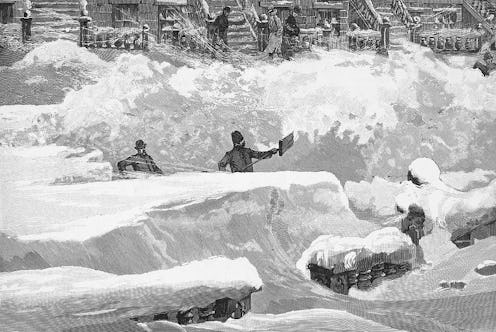
We may all be bracing ourselves for Winter Storm Juno — but she's got a lot to live up to if she really wants the title of Worst Storm Ever. In the late 19th Century, the East Coast got slammed with the Blizzard of 1888, and you guys? The word "doozy" doesn't even begin to cover it. It's known as the Great White Hurricane, and if these old newspaper images are anything to go by, it's not a thing we'll ever want to experience again. How is Juno gong to stack up against the Blizzard of 1888? To get a rough estimate, let's compare a few of these "then" images with pics from some of the storms we've had in recent years, shall we?
The website My Inwood, which focuses on the Inwood neighborhood of Manhattan, recently dug up a report published by the New York Herald in the aftermath of the Great White Hurricane; it's from this report that these images hail, and even as artist's renderings, they're all kinds of powerful. According to AccuWeather's "On This Day in Weather History" web series, the storm paralyzed the East Coast between March 11 to March 14; it stretched from the Chesapeake Bay aaaaaaaaaaall the way up to Maine — somewhere in the neighborhood of 600 miles (Juno's 250 miles don't seem so bad in comparison, do they?). The weather prior to the blizzard actually sounds pretty similar to what we've been having in the Tristate Area lately: Unseasonably warm temperatures with a lot of rain. When the temperature dropped, of course, the rain turned to snow, and voila — Snowmageddon, 1888 Edition.
Snow began falling on March 12 and barreled down from the sky for a day and a half. Across the Northeast, snowfall totaled 40 to 50 inches (roughly three to four feet); winds gusted at over 45 MPH; and snowdrifts grew to a whopping 50 feet. 50 effing feet. That's bigger than a lot of houses. Some 400 people perished during the storm, with 200 of them being from New York City alone.
The Herald's report paints a less statistic-driven picture of the event as it played out in New York — a more human one, if you will. Here's what the headlines looked like then; today's have been pretty similar, all things considered:
The Herald's writers speak of people "[cutting] through gigantic drifts in order to release people who were imprisoned in their own houses"; of "dreadful stories of whole trainloads of passengers imprisoned in the snow, without food or the slightest means of escape"; of people seeking refuge wherever they could; of those not fortunate enough to find that refuge in time; and of the absolute isolation, with no being able to get either in or out of the city. When the zombie apocalypse comes, I suspect it will be kind of like this — just with more walkers and hopefully less snow (depending on the time of the year).
Interestingly, although perhaps unsurprisingly, the Blizzard of 1888 is credited with inspiring a lot of city-wide innovations in New York we still use today: It's the reason telephone lines run underground (the telegraph lines were down for an absurd amount of time due to, y'know, having been destroyed during the storm), and it's partially responsible for the creation of the subway. The city wasn't at all ready when it struck, and it vowed never to be caught with its proverbial pants around its ankles again. Alas, it kind of forgot that vow over time — but in recent years, it's been galvanized back into action due to other storms: Snowpocalypse 2010 (I was trying to get home from JFK in the middle of that one — boy, was that fun!), Irene, Sandy, the polar vortex, and now Juno. Now we just have to hope we don't forget again.
Head on over to My Inwood to see more images and to read the full report; in the meantime, here's hoping we all make through unscathed. Stay warm, safe, and dry, everyone!
Images: The New York Herald (5); Getty Image (4)